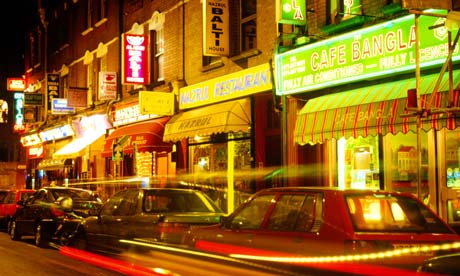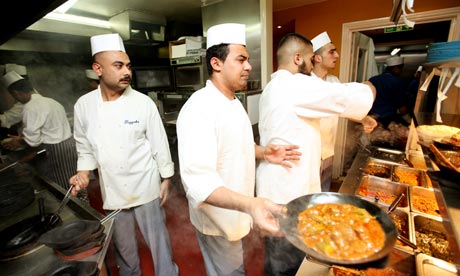The web page carrying the piece is as follows:
http://www.guardian.co.uk/lifeandstyle/2012/jan/08/britains-curry-crisis-chefs-immigration?commentpage=all#start-of-comments
The curry crisis
Chicken tikka masala is now an integral part of British culture, but can our curry houses survive the recession – and the government's immigration policy?

It's a cold, rainy day in Bradford and the balti restaurants and fast food outlets offering "desi" [Asian] milkshakes, have yet to fill up. But close by, the industrial kitchen of the International Food Academy is already buzzing with activity. Angelo Towse, 33, is frowning in concentration as he carefully folds, and stuffs, samosas. By the stainless steel sinks, former bricklayer Joel Stafford, 26, is patting mince on to skewers for kebabs while Awais Mumtaz, 20, whose father owns Mumtaz, one of Bradford's best-known restaurants, is learning to make a stuffing and roast potatoes. It may not quite equal the heat and noise of an Indian restaurant, but kitchens like this could be the future of the British curry industry.
Since May, Bradford College has been training 50 youngsters to make – alongside Chinese and English dishes – curries, rotis and samosas. The dishes are sold everyday in the college canteen to students and staff – and while it may not be exactly the same as Mummyji used to make, the seekh kebabs, lamb green chilli, fish tikka masala and naan I try are fresh and tasty. There are plans to expand the course to 100 students this year, and programme director Graham Fleming hopes to persuade local restaurants to fund a city-centre premises, with branded stations where students can learn to cook in the style of the sponsor's kitchen. "We started with no intention of becoming a 'curry academy'," Fleming says. "But because of the cry from the Asian sector we thought we would focus on that and get the restaurants to support what we are doing."
Bobby Patel, from nearby Prashad, whose head chef – his wife Minal – teaches at the academy, says the project makes sense since the recession left a million young people out of work. "My younger brother is looking to develop into fast lunchtime food – wraps, paninis. We are looking to people who have had an exposure to Asian cuisine; they have had health and safety training, and they are hungry for a career."
It should be music to the ears of Eric Pickles who, in reports that delighted headline writers in November, suggested a "curry college" to train British people to become chefs in Indian restaurants. While his Department for Communities and Local Government refused to confirm, or expand on, the idea, which is believed to be part of the government's integration strategy, it issued a statement saying: "The government is continuing to look at how it can best support British talent in Asian cuisine, working with the sector to ensure employees have the right skills."
The bland words hide a growing crisis in the country's curry industry. The figures for the sector may seem robust – the trade magazine Spice Business, for instance, suggest that, every week, 2.5 million customers eat in one of 10,000 restaurants employing 80,000 staff, making the industry worth £3.6bn (not all sources are so generous – the industry authority the Curry Club puts the sector's turnover at £2.5bn, while food industry analysts Horizons FS put it at £777m). And by 2002, Indian food in supermarkets alone was worth £600m – 80% of which was ready-meal curries.
David Cameron certainly thinks the Asian entrepreneurs involved in the business are important enough to cultivate. Last month, he joined, albeit by videolink, an unlikely set of guests, including Charlie Brooker and Boris Johnson, at the industry's British Curry awards. According to its enthusiastic founder Enam Ali (who also owns Spice Business magazine), the glamour and power on display could rival the Oscars.
But the night's glitter could not hide the anxiety of an industry squeezed between the recession and the government's strict immigration policy. Made up of independent, small – and for the most part family-run – businesses, curry houses have been hit hard as customers eat at home. Analyst Peter Backman, of Horizons FS, says that while the restaurant industry has just stopped growing, the Indian restaurant sector is doing even worse, with profits falling. Pat Chapman, founder of the Curry Club, and author of the Good Curry Guide, notes, "You just instinctively know they are struggling", while Backman adds that he is "increasingly gloomy" about the sector's outlook for the next few years, believing Indian restaurants will "continue to lose share to the rest of the eating out market" if the recession continues.
The sector is already reeling from the effect of the government's restrictions on south Asian chefs. For years, the skill and pay levels required for chefs to enter Britain has been a cause for concern. In 2008, Ali warned that the policy could "decimate" the industry, which relies on foreign chefs to whip up everything from Sinhalese string hoppers to various vindaloos. And raids on restaurants that ignore the rules are common. But then, in March, the desire to slash immigration figures even further led the government to announce only the top 5% of the most skilled chefs – who must earn more than £28,260 per year – now qualify for admission to the UK.
According to Ali, this has left one in four vacancies in Indian restaurants unfilled. "It's a very difficult time," he says. "I want to make sure my son and daughter are involved in the industry and a new generation is engaged. But if you don't have a chef, you can spend millions on a restaurant but you will go bankrupt." Smaller outlets have complained the vacancies are changing the food they serve, making them rely on easier-to-make fusion dishes, and warning that frozen food will become more commonplace. At the other end of the sector, Ranjit Mathrani, the chief executive of Masala World, which employs 5,000 people and, among others, owns London's Veerasawamy, the country's oldest surviving Indian restaurant, claims the chef shortage has brought the group's expansion up short as surely as the recession.
The company, he points out, could not use "curry college" chefs, because they only allow chefs to cook dishes from their home regions, he says, so they can offer their customers authentic Indian food. "There are still opportunities, but we have had to hold back. We have stopped expanding in London because of the government's rules, which are misguided. If we can't get the chefs, we have no other option but to look abroad."
He points out that despite advertising in jobcentres and being happy to take on apprentices, few British applicants come forward for jobs at his restaurants. Second-generation British Asians are reluctant to join the industry, including the children of restaurant owners. Wasim Tayyab, who along with his three brothers and wife runs Tayyabs restaurant in Whitechapel in east London, which his parents set up in 1972, says his situation is rare. "I have been working here since I was 17 and I'm 37 now," he says. "I started on the basics, peeling, washing, cleaning. I wanted to do this, but your social life goes out of the window."
 In the kitchen of Tayyabs, the curry house in Whitechapel that has become an east London institution. Photograph: Graeme Robertson for the Guardian
In the kitchen of Tayyabs, the curry house in Whitechapel that has become an east London institution. Photograph: Graeme Robertson for the Guardian The sector also has an image problem, according to Ali: "My son's generation feel embarrassed to work in the Indian restaurant industry. They think it undervalues their skills and it has a stigma attached." And many restaurant owners also prefer more aspirational careers for their children, such as medicine or accountancy.
In his cut-glass accent, Mathrani says the government's policy does not distinguish between restaurants that serve specific, regional dishes, which he considers part of the ethnic food market, and the majority of curry houses which, he points out, serve "a form of cooking curries which is indigenous to the UK and that does not exist in authentic Indian cooking in India. They are not Indian restaurants in the proper sense of the word."
It is a common argument. The term curry has no equivalent in India. While Indian restaurants first appeared in England in the 19th century, catering for Asian seamen and students, and then multiplied in the 1950s and 60s to feed the newly arrived south Asian factory workers, their boom time only begun in the 70s, when they adapted their menus for a working-class, white clientele. By 1982, there were 3,500 Indian restaurants in Britain and "going for a curry" became a standard evening out. Today it may be more fashionable to profess a love for south Indian dosas or Kashmiri rogan josh, but specialist regional restaurants are still a minority. Bangladeshis run 85-90% of the Indian restaurants in the UK, most of which rely on tried and tested Anglicised favourites such as vindaloo or tikka masala.
This journey from exotic treat to British comfort food, however, has given curry an emotional pull few other cuisines can rival. That has been something politicians are happy to point out – the late Robin Cook, for instance, memorably announced that chicken tikka masala is the nation's favourite dish. But the way Indian food has been received has also highlighted tensions around the south Asian diaspora. The rule change to clamp down on chefs, for example, is seen by many as targeting immigrants from south Asia in the context of other mooted policies such as raising the age of spouse visas or raising the income threshold for those who wish to bring family members to the UK. In the 60s and 70s, anxieties about south Asian immigration were often voiced under the cover of complaining about the smell of curry, according to Elizabeth Buettner of the University of York. In the Journal of Modern History, she points out "the view that Asians and their surroundings 'stank of curry' … became deployed by landlords to explain why they refused Asians as tenants". In factories, too, British workers are reported to have refused to work with Asian immigrants "because they could not bear the smell of garlic". The insistence on cooking curries was also seen as an indication of the new immigrants' refusal to assimilate.
But walking down London's Brick Lane, with its razzle of neon lighting, discount offers and lengthy Identikit menus, it is easy to see how curry houses have adapted to meet demand, just as the British grew to love curries. Yet the lines of small competing restaurants also highlight the problems inherent in the industry's economic model. Offering cheap meals to young people in a newly affluent society was possible through cutting corners in the preparation of the food, but also by paying low wages to staff. So perhaps it is no surprise that on the same day restaurant owners at the British Curry awards were watching dazzling dance troupes, a group of restaurant workers from the newly formed Bangladeshi Worker's Union voted to join the GMB in a bid to improve conditions.
Organisers were told of waiters, chefs and porters paid below minimum wage and made to work extraordinarily long hours, with no paid holiday and no sick pay.
One former restaurant worker who joined up points out this was possibly, in part, because so many of the workers were vulnerable, recent immigrants. "Some owners treat workers like animals," he says. "Sometimes they just pay £3.50 an hour. If, after one or two years, they ask for more – maybe minimum wage – they are told to leave. They can't speak English, so they take this opportunity to work. I have friends all over the UK who are from Bangladesh and they face the same conditions."
Tessa Wright, of Queen Mary, University of London, who interviewed ethnic minority and migrant workers in the catering and hotel industry in 2005, said 50- to 60-hour weeks were common for workers. "Conditions were pretty awful," she says, but owners gave the impression that they believed the authorities knew about it. "It was kind of accepted that this is how these sorts of business ran."
Azmal Hossein runs four restaurants on Brick Lane and helped set up the union to end the exploitation. He thinks a curry college could help – if it was funded properly. "If the [Asian] workers here had proper rights, they wouldn't need to import [more] people. It makes me angry. Bangladeshi chefs don't have the health and safety or hygiene training they need here."
Yet restaurant owners say that while a string of colleges with good teaching could help ease the problem for certain restaurants, it would not suit all restaurants – and it may not be enough to protect the industry. Mathrani, among others, points out it would take years to train chefs to the standards he requires for a specialist restaurant if they had not grown up with the food. And Backman points out it would not solve the problems of the recession. "When Indian food came in, it offered a new eating out experience, but it has not moved on beyond that," he says. "I think the Indian restaurant market needs to reinvent itself . It needs a high-spending demographic."
Patel agrees: "People want a change. So far, innovation in the Indian restaurant scene has been about ambience – going upmarket and being contemporary – but how much more contemporary can you be than your last neon-style restaurant?" Having been in the final of TV reality show Ramsay's Best Restaurant he thinks there is now a focus on innovation in the kitchen and a changing serving style. His Gujarati restaurant, Prashad, focuses on modern Indian cooking, he says, and takes inspiration from leading London restaurants The Cinnamon Club and Tamarind.
So is this the death of the curry house as we know it? At 2.30pm on a Thursday, I visit a slightly scruffy, packed Pakistani restaurant round the back of the East London mosque. A group of young women in bright headscarves are heading for the door past a boisterous group of lunching office workers in suits. On my right, doctor Nadia Javed is tucking into her lamb karahi with rice and naan in her lunch break from the nearby Royal Infirmary, while on my left cab driver Simon Hope, 32, has popped in between fares to wolf down a huge meal of lamb chops, lamb karahi, prawns and naan. Both are regulars at Tayyabs, a London institution, famous for its long queues and low prices. A plate of spicy lamb chops is placed in front of me. It sizzles so loudly it sounds like a round of applause for an industry that deserves to be celebrated.


No comments:
Post a Comment
Note: only a member of this blog may post a comment.